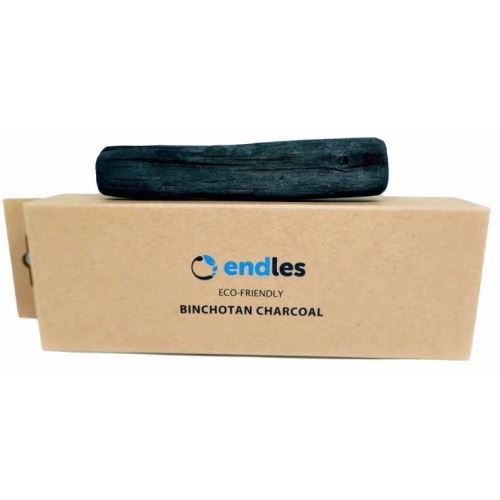Binchotan stick, 35 - 45 g
Would you like help with your purchase? Don't know how to choose a product? Email us at: info@ekokoza.com.
If you are interested in B2B cooperation contact us at email: b2b@ekokoza.com.
Coal is no longer just for naughty children! The binchotan stick, on the other hand, is a reward. In Japan, this charcoal has been used for natural water purification for several hundred years. It reduces the amount of chlorine, neutralizes electromagnetic waves, adds minerals to the water and balances the pH. And you can tell the difference in the taste. The stick will make your drinking regime more pleasant for about half a year. You can then feed your plants with it or use it as an odor absorber.
Material: binchotan or activated carbon (100% natural raw material)
Packaging material: cardboard box suitable for volume: approx. 1 liter of water
How to use binchotan?
- The manufacturer recommends boiling the bar before first use. Purely for hygienic reasons. Drop the stick into a liter of drinking water, ideally in a glass carafe or bottle.
- After an hour, the water is largely "filtered", but the best effect is achieved after several hours of exposure (preferably overnight).
- We recommend leaving the bar in the bottle and simply adding water continuously - that's how we do it ourselves.
- Binchotam will reduce the amount of chlorine, add minerals and a slightly sweet taste to the water.
- Replace it with a new one after 4-6 months. Give him some love after 3 months. Rinse the stick with water and brush. Do not use detergent.
- Boil it in water for 10-30 minutes. Allow to dry freely - preferably in the sun.
- Through this process, the stick should release impurities from the micropores and thereby restore its adsorption capabilities.
- However, by researching other manufacturers, we came across different opinions regarding boiling the stick. Some have stated that boiling the stick does not restore adsorption capacity due to the fact that the toxins are bound to the pores at a molecular level, which simply boiling cannot remove.
- We recommend sticking to the manufacturer's instructions and your own gut feeling. You will find out for yourself when the stick no longer fulfills its filtering capabilities based on the taste of the water and will need to be replaced (4 to 6 months).
What about the binchotan when it matures?
- Stick it in the fridge, shoebox or cat litter box. In short, near the places where you sometimes pick your nose. Binchotan can also absorb odors.
- Fertilize the plants with it. It will improve the quality of the soil and help the plants to grow faster.
- Slip him into your shoes. The stick will help absorb excess moisture and unpleasant odor.
- What about packaging: Recycle the box in a paper container, or you can compost it
How exactly does activated charcoal work?
Activated carbon has a porous structure and a huge internal surface (1,000 to 2,000 m2/g depending on the type of source used). This means that a teaspoon of activated charcoal represents a surface area equal to a football field. It is the enormous internal surface area that gives it its unique ability to adsorb a wide range of components from the liquid and gas phase. The essence of the process is physical adsorption. The adsorption capacity of binchotan is determined by the size of the pores, the surface area and the chemical reactivity of the surface.
Filtering is active, i.e. that coal attracts non-polarized molecules dissolved in water to its surface, which then adsorb and diffuse into the inner sphere of the pores. There, the molecules are bound by weak van der Waals forces. That is why activated carbon is also used for filtration in professional laboratories.
Binchotan's filtering ability works great on non-polarized molecules. This includes most organic pesticides, surfactants, phenols and petroleum, but also heavy metals (arsenic, chromium, mercury, lead, nickel, etc.), benzene and other chemicals. Conversely, it is not effective on polarized molecules.
How is binchotan made?
The wood for binchotans comes from Laos, from cuttings of Quercus phillyraeoides (ubamegashi oak) trees. It is first dried for 1 month and then fired in a kiln at low temperatures. At the end of firing, the temperature rises to 1000 °C and then cools down quickly. A rapid rise in temperature followed by rapid cooling will burn off the bark, leaving a smooth, hard surface. After that, the surface of the sticks is covered with a special powder made of clay, sand and ash, which achieves a whitish shade (see the name "white coal").
The heat treatment process of the bars takes 21 days. The charcoal is then cut at both ends and polished, cleaned and sterilized by ultrasound (at high temperature and high pressure). Binchotans are packed individually for hygienic reasons. Each bar is steam and ultrasonically cleaned, dried and packaged so that it is ready for immediate use.
Oak wood is extremely hard, and this is one of the reasons why the stick does not float on the surface. During growth, the tree absorbs a lot of nutrients and minerals, which then partially remain in the binchotan and are transferred to the water.
Notice
It is for use exclusively with potable water.
| Length (mm) | 115 |
| Unit weight (g) | 40 |
| Package size | 1 |
| Country of origin | Taiwan |
Ekokoza likes cookies! Cookies help us offer the right products, nice discounts and other great services. Just give us your consent to use them.



